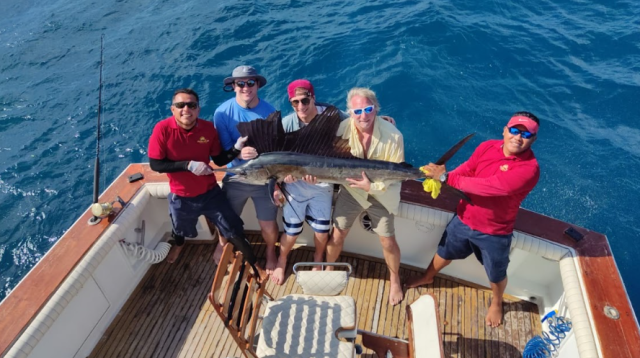In the world of fishing, mastering different techniques can make the difference between returning home with a good catch or returning empty-handed. So, let's explore and see what five proven and effective fishing techniques are all about that can help you improve your catching success. From fly fishing to trolling, each method has its own quirks and benefits. For many people, fishing is not just a recreational activity, but a deep-rooted passion that provides a peaceful and rewarding escape. For these enthusiasts, spending hours on the bank of a river, in the middle of a lake or in the sea, with the rod in hand and the hope of catching the perfect fish, is a way of connecting with nature and with themselves. The feeling of anticipation when casting the hook, the excitement of feeling a bite and the satisfaction of achieving the catch are moments that fuel his love for recreational fishing.
You may also be interested in: sport fishing tour in Santa Marta
1. Fly fishing
Fly fishing is an artisanal technique that requires precision and patience . Anglers use specialized equipment such as fly rods, reels, and lines designed specifically to cast artificial flies that imitate insects and other natural fish foods. Choosing the right fly and delicate presentation are key to attracting fish, as this technique focuses on tricking the fish into taking the bait.
In addition to equipment, fly fishing also involves a deep understanding of the aquatic environment and fish behavior. Anglers should carefully observe the water to identify the presence of insects and other natural foods that may attract fish. Casting technique, which requires fluid, controlled movements , is crucial to accurately placing the fly where the fish are. That is, fly fishing is a combination of technical skill, knowledge of the environment and patience, which can provide rewarding and exciting experiences in the wild.
-
Essentials: rods, reels, lines and flies.
-
Throwing techniques: overhead throw and roll cast throw.
-
Fly selection: based on water conditions and fish behavior. Also, you can observe the environment to identify the presence of insects and other natural foods that may attract fish.
2. Trolling
Trolling, also known as trolling, is a popular technique that involves dragging lures through the water from a moving boat. This method is commonly used in deep water to catch large fish such as tuna, sailfish, and marlin. Anglers adjust the speed and depth at which lures are trolled to attract different species, and specific lures designed to mimic the fish's natural prey are often used.
In addition to specialized equipment, trolling requires navigation skills and knowledge of the marine environment. Anglers should identify promising areas where fish activity is likely, such as currents, changes in water temperature, or underwater structure. The ability to adjust your trolling route and adapt to changing water conditions can make the difference between a successful day of fishing and one without a catch.
Some aspects to take into account:
-
Speed and Depth: Explore how to adjust the speed and depth of your lure to attract different species of fish.
-
Choice of lures: such as spoons, rapalas and sinking lures.
-
Specialized equipment: trolling reels and trolling rods, which can improve the effectiveness of this technique.
3. Freshwater fishing with lures
Freshwater lure fishing is a versatile and exciting technique practiced in a variety of environments such as rivers, lakes and reservoirs. Anglers use a wide range of artificial lures , such as crankbaits, spinnerbaits, jigs and swimbaits, to imitate fish's natural prey and attract their attention. This technique requires skill in selecting the right lure and casting technique, as well as a good knowledge of fish behavior in different conditions.
In addition to equipment and technique, freshwater lure fishing also involves exploring the terrain and adapting to changing water conditions. Anglers look for promising areas, such as deep water access points and areas with vegetation cover, where fish are most likely to be found. The ability to adjust your fishing technique based on water conditions and fish activity is key to success.
Important aspects:
-
Choice of lures: crankbaits, spinnerbaits and jigs.
-
Retrieval techniques: such as constant retrieving, jigging and twitching, and how to apply them depending on water conditions and fish behavior.
-
Mimicry: It is important to mimic the behavior of natural prey and adjust the lure presentation accordingly.
4. Fishing with Live Bait
Live bait fishing is a classic and effective technique that involves using living organisms as bait to attract fish. Anglers typically use a variety of live bait, such as worms, small fish (such as sardines or minnows), and shrimp, depending on the species of fish they are targeting and the conditions of the environment. One of the advantages of this technique is its ability to naturally imitate fish food, which increases the chances of capture.
However, live bait fishing also requires specific skills, such as selecting and properly handling the bait to keep it alive and active, as well as presenting the bait so that it appears as natural as possible. Anglers must be patient and watch for subtle signs that indicate the presence of fish, such as small tugs on the line or changes in bait behavior. This traditional technique can provide great rewards in terms of catches, but requires practice, patience and a good knowledge of the behavior of the fish and their environment.
Important points to consider:
-
Choice of bait: worms, small fish and shrimp, among others.
-
Presentation Techniques: Know how to present bait in a natural and attractive manner, whether using floating, suspended or bottom rigs.
-
Equipment selection: hooks and tackle, for fishing with live bait.
5. Shore Fishing
Shore fishing, also known as shore fishing, is a popular technique that involves fishing without the need for a boat. Anglers can practice this technique in a variety of environments, such as rivers, lakes, ponds, and even the sea coast. One of the advantages of shore fishing is its accessibility, as you do not need specialized equipment or a boat to participate. In addition, fishing from the shore can offer a calmer and more relaxing experience, since anglers can enjoy the landscape and nature while waiting for the fish to take the bait.
To be successful at shore fishing, anglers must carefully choose the right location to fish, looking for areas with vegetation cover, underwater structure, river mouths, or other deep water access points where fish are most likely to be found. Additionally, it is important to take into account factors such as time of day, weather conditions, and season, as these can affect fish activity and fishing effectiveness.
To be successful from the shore:
-
Throwing Technique: Explore different throwing techniques such as the slope throw, side throw, and low throw.
-
Mobility: It is important to move along the coast to explore different areas and maximize catching opportunities.
The most used fishing style may vary depending on geographical location, the personal preferences of the anglers and the type of fish they wish to catch. However, one of the most widely used and popular fishing styles around the world is fishing with artificial lures, whether in fresh or salt water, which offers several advantages that make it attractive to many anglers and can be more active, Exciting and environmentally friendly compared to other techniques, as it requires the angler to constantly cast and retrieve the lure, which can be more rewarding for those who enjoy a more dynamic fishing experience. It also offers a greater sense of accomplishment when making a catch, as it involves tricking the fish into taking an artificial lure.
Mastering these five fishing techniques can significantly improve your catching success and turn your fishing trips into memorable experiences. Whether you prefer fly fishing in crystal clear streams or exciting deep water trolling, there is a technique for every angler and every situation!
We invite you to take a look at other articles at: https://yate.co/es/blog


